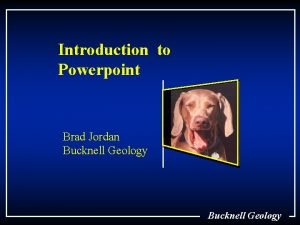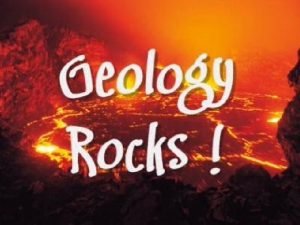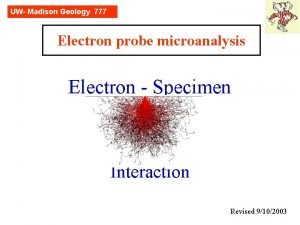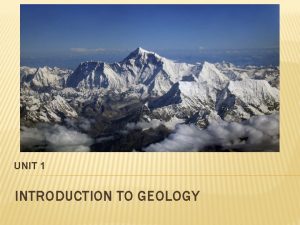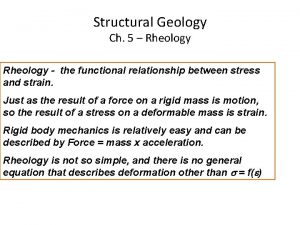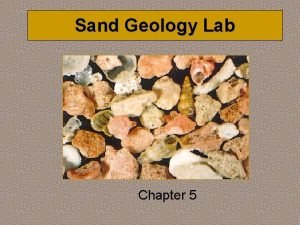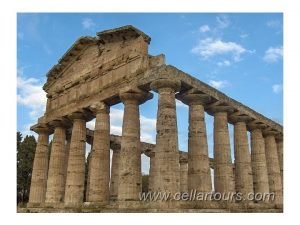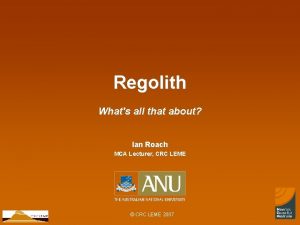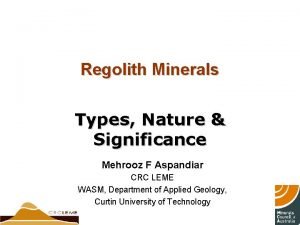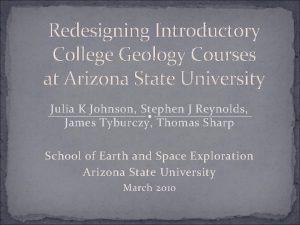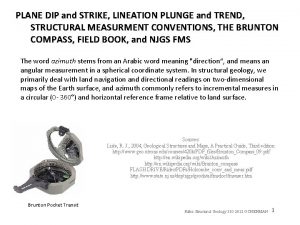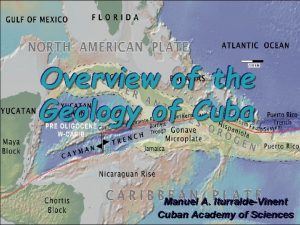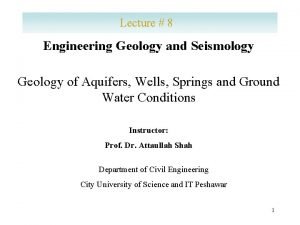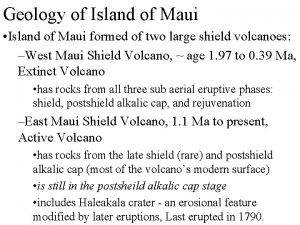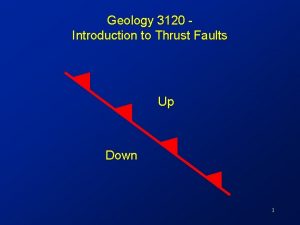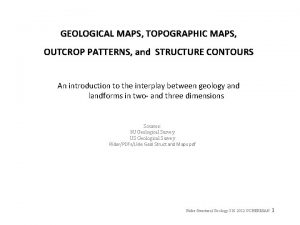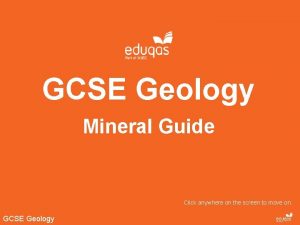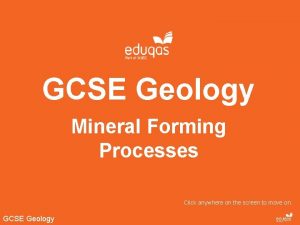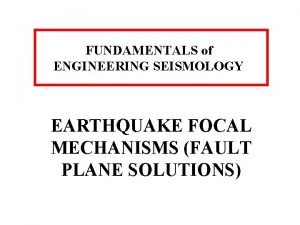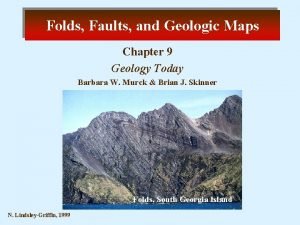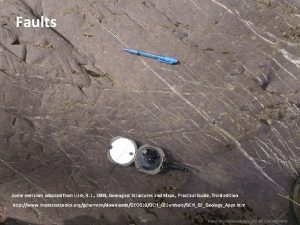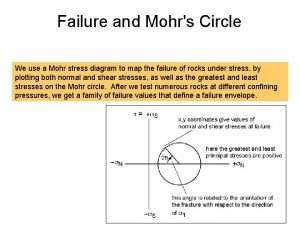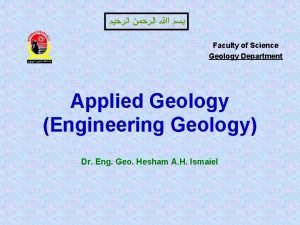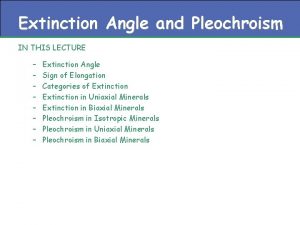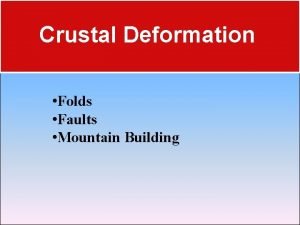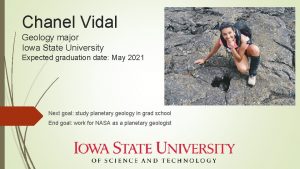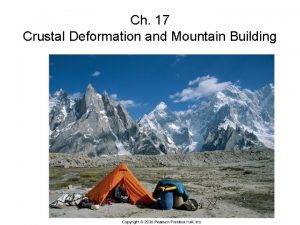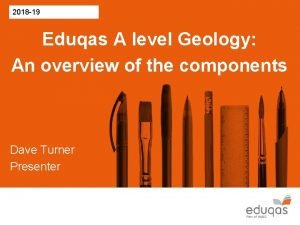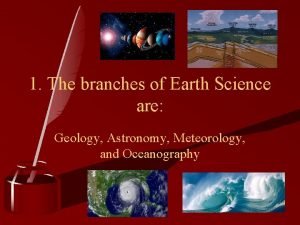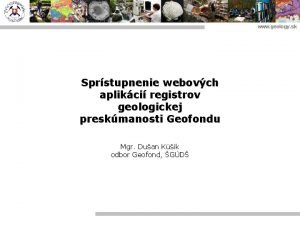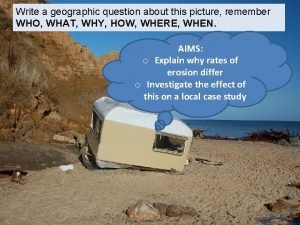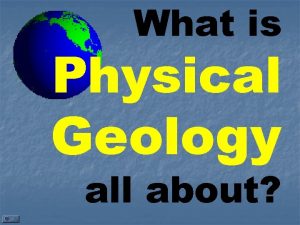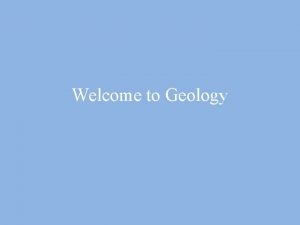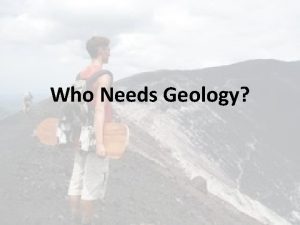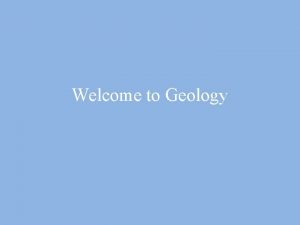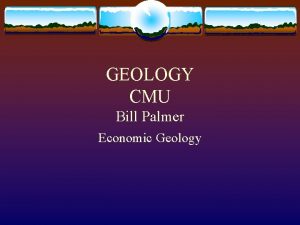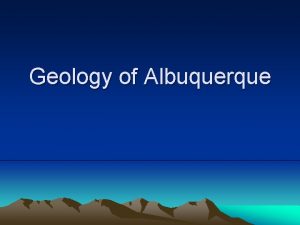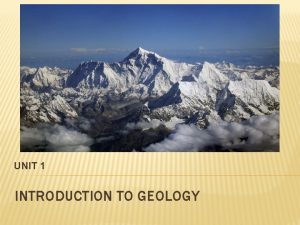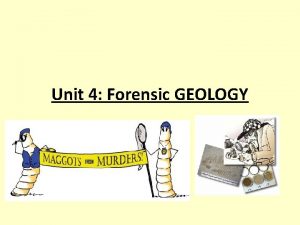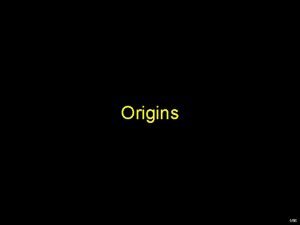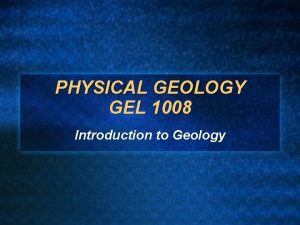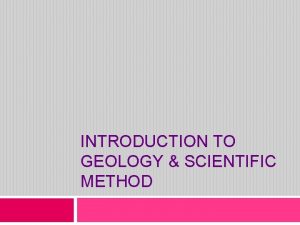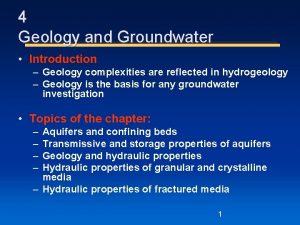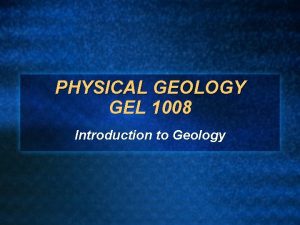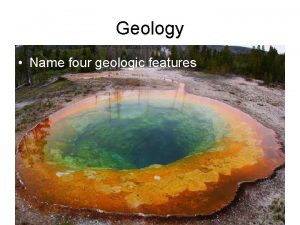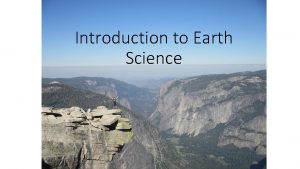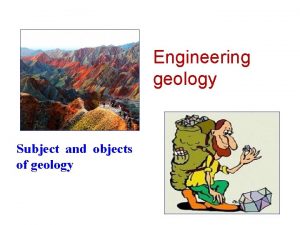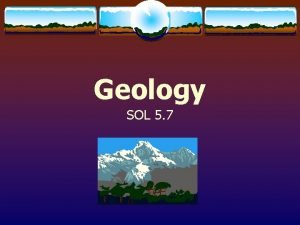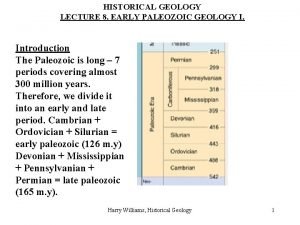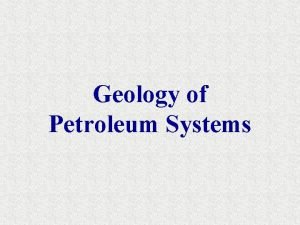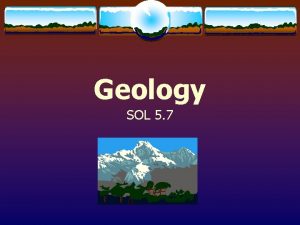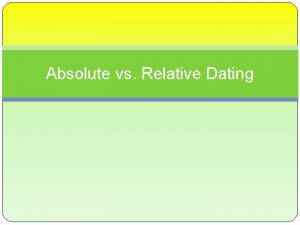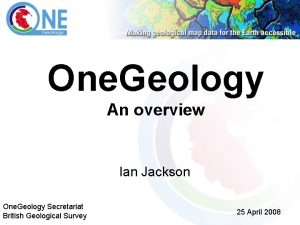UNIT 1 INTRODUCTION TO GEOLOGY WHAT IS GEOLOGY





































- Slides: 37

UNIT 1 INTRODUCTION TO GEOLOGY

WHAT IS GEOLOGY Ø Geology is the study of Earth, including the materials that it is made of, the physical and chemical changes that take place on its surface and in its interior and the history of the planet and its life form. Ø Geology is broadly divided into Physical Geology and Historical Geology. • Physical geology is concerned with the materials and processes which compose and operate on the surface of, and within the Earth. • Historical geology is concerned with the origin and evolution of Earth's continents, oceans, atmosphere, and life.

BRANCHES OF GEOLOGY

GEOLOGY IN OUR LIVES Ø Geology is relevant everyone’s day-to-day life. to Ø Metals and energy sources such as coal and petroleum are geologic products that build and power modern society. Ø Water, a precious natural resource is used in industry, agriculture and domestic purpose is also a geologic product. Ø Natural hazards like tsunamis, landslides, earthquakes and volcanic eruptions are also related to geology,

WHAT DOES A GEOLOGIST DO Ø Geologists work to understand the history of our planet. The better they can understand Earth’s history the better they can foresee how events and processes of the past might influence the future. Ø Geologists study earth processes: Ø Ø Ø Geologists study earth materials: Ø Ø Ø Many processes such as landslides, earthquakes, floods and volcanic eruptions can be hazardous to people. Geologists work to understand these processes well enough to avoid building important structures where they might be damaged. If geologists can prepare maps of areas that have flooded in the past they can prepare maps of areas that might be flooded in the future. These maps can be used to guide the development of communities and determine where flood protection or flood insurance is needed. People use earth materials every day. They use oil that is produced from wells, metals that are produced from mines, and water that has been drawn from streams or from underground. Geologists conduct studies that locate rocks that contain important metals, plan the mines that produce them and the methods used to remove the metals from the rocks. They do similar work to locate and produce oil, natural gas and ground water. Geologists study earth history: Ø Ø Today we are concerned about climate change. Many geologists are working to learn about the past climates of earth and how they have changed across time. This historical geology news information is valuable to understand how our current climate is changing and what the results might be.

WHERE DO GEOLOGISTS WORK Ø Jobs in geology are found in government agencies, private companies, and non-profit and academic institutions. Ø Government agencies hire geologists to investigate, plan and evaluate excavations, construction sites, natural disaster preparedness, and natural resources. Ø Private companies hire geologists to help locate natural resources (minerals, oil and natural gas), evaluate environmental impact and comply with government regulations, among many other tasks. Ø Geologists who prefer an academic career usually work, either as educators, researchers or both, in middle or high schools, colleges, universities and museums.

PROCESSES ACTING ON THE EARTH Ø The Earth is a Dynamic system that is it undergoes constant changes with time both internally and on its surface. Internal Processes Ø Processes that originate deep within the Earth are termed as internal processes. These are the driving forces that raise mountains, cause earthquakes and produce volcanic eruptions. Surface Processes Ø Surface processes are all those processes which take place on the earth’s surface and result in sculpting the earth’s surface. Most of the surface processes are driven by water, though wind, ice and gravity also play an important role.

GEO-SPHERES Ø The area near the surface of the earth can be divided into four inter-connected "geo-spheres: " the atmosphere, hydrosphere, lithosphere and the biosphere.

ATMOSPHERE Ø The atmosphere is the body of air which surrounds our planet. Ø Most of our atmosphere is located close to the earth's surface where it is most dense. Ø The atmosphere not only provides the air that we breathe but also acts to protect us from the Sun’s intense heat and dangerous ultraviolet radiation. Ø The energy exchanges that continually occur between the atmosphere and the surface and between the atmosphere and space produce the effects we call weather and climate. Ø The air of our planet is 79% nitrogen and just under 21% oxygen; the small amount remaining is composed of carbon dioxide and other gasses.

HYDROSPHERE Ø The hydrosphere is composed of all of the water on or near the earth. Ø This includes the oceans, rivers, lakes, and even the moisture in the air. Ø Ninety-seven percent of the earth's water is in the oceans. Ø The remaining three percent is fresh water; three-quarters of the fresh water is solid and exists in ice sheets.

LITHOSPHERE Ø Beneath the atmosphere and the oceans is the solid Earth, or lithosphere. Ø The lithosphere is the solid, rocky crust covering entire planet. Ø This crust is inorganic and is composed of minerals.

BIOSPHERE Ø The biosphere is composed of all living organisms. Ø Plants, animals, and one-celled organisms are all part of the biosphere. Ø Most of the planet's life is found from three meters below the ground to thirty meters above it and in the top 200 meters of the oceans and seas.

UNIFORMITARIANISM AND CATASTROPHISM Ø James Hutton a Scotish gentleman in 18 th century gave the concept of Uniformitarianism. Ø According to the Principle of Uniformitarianism, geological changes take place over a long period of time. Ø Hutton summarized that geological processes operating today also operated in the past therefore scientists can explain events that occurred in the past by observing changes that are occurring today. Ø Sometimes this whole idea is also known as “The present is the key to the past. ”

UNIFORMITARIANISM The formation of river valleys due to the action of running water or the movement of the continents are examples of very slow and gradual changes

UNIFORMITARIANISM AND CATASTROPHISM Ø William Whewell, another early geologist, agreed that the Earth is very old, but he argued that geologic change was sometimes rapid. Ø He wrote that the geologic past may have “consisted of epochs catastrophic action, interposed between periods of comparative tranquility. ” Ø This phenomenon where earth was subjected to rapid geological change as a result of certain catastrophe came to be known as Catastrophism

CATASTROPHISM

UNIFORMITARIANISM AND CATASTROPHISM Ø Today, geologists know that both Hutton’s uniformitarianism and Whewell’s catastrophism are correct. Ø Thus, over the great expanses of geologic time, slow, uniform processes are significant, but improbable, catastrophic events radically modify the path of slow change.

FORMATION OF THE SOLAR SYSTEM Ø Earth was not around at the beginning—the universe began without us some 10 billion years earlier than Earth. Ø The universe started out with only two elements, hydrogen and helium gas. Ø They formed stars that burned these elements in nuclear fusion reactions. Ø Generations of stars were born in gas clouds and died in explosive novas. Ø Long, long ago (some 5 billion years ago) a supernova exploded, pushing a lot of its heavy-element wreckage into a nearby cloud of hydrogen gas https: //youtu. be/IRZYMim. UET 8

FORMATION OF THE SOLAR SYSTEM Ø The mixture grew hot and compressed under its own gravity, and at its center a new star began to form. Ø Around it swirled a disk of the same material, which grew white-hot from the great compressive forces. Ø That new star became our Sun, and the glowing

FORMATION OF THE SOLAR SYSTEM

FORMATION OF THE SOLAR SYSTEM Ø The planets of the Solar system can be divided into groups depending on their proximity to the sun and their density. Ø The terrestrial planets are the four closest to the sun and are all similar to the Earth in density. They include Mercury, Venus, Earth and Mars. All four terrestrial planets are small, rocky and dense (3 g/cm 3 or more).

FORMATION OF THE SOLAR SYSTEM Ø The Jovian planets are those farther from the sun than Mars Ø They include Jupiter, Saturn, Uranus and Neptune. They are much larger than the Earth but their densities are very low. Ø They are made up of light elements most Hydrogen and Helium and hence their densities are low,

FORMATION OF THE EARTH Ø The Earth is approximately 4. 6 billion years old and is believed that it was formed by accretion of small particles. Ø The Earth has a layered structure. The center is a dense, hot core composed mainly of iron and nickel. Ø A thick mantle, composed mainly of solid rock, surrounds the core and contains 80 percent of the Earth’s volume. Ø The crust is a thin surface also composed of rock.

STRUCTURE OF THE EARTH 1. CRUST (CONTINENTAL/OCEANIC) 2. MANTLE 3. CORE (OUTER/INNER)

LAYERS OF THE EARTH

THE CRUST Ø The crust, Earth’s relatively thin, rocky outer skin, is of two different types— continental crust and oceanic crust. Ø The oceanic crust is roughly 7 kilometers thick and composed of the dark igneous rock basalt. Ø The continental crust has an average thickness of about 35 kilometers and is composed mainly of light colored igneous rock called granite. Ø Continental rocks have an average density of about 2. 7 g/cm 3, and are older in age (up to 4 billion years old). Ø The rocks of the oceanic crust have an average density of 3. 0 g/cm 3 and are younger in age (180 million years or less).

THE MANTLE Ø More than 82 percent of Earth’s volume is contained in the mantle, a solid, rocky shell that extends to a depth of nearly 2900 kilometers. Ø The boundary between the crust and mantle represents a significant change in chemical composition. Ø The dominant rock type in the uppermost mantle is peridotite, which is richer in the metals magnesium and iron than the minerals found in either the continental or oceanic crust.

THE CORE Ø The composition of the core is thought to be an iron-nickel alloy with minor amounts of oxygen, silicon, and sulfur—elements that readily form compounds with iron. Ø At the extreme pressure found in the core, this iron-rich material has an average density of nearly 11 g/cm 3. Ø The core is divided into two regions that exhibit very different mechanical strengths. Ø The outer core is a liquid layer 2270 kilometers thick. Ø It is the movement of metallic iron within this zone that generates Earth’s magnetic field. Ø The inner core is a solid sphere having a radius of 1216 kilometers. Ø Despite its higher temperature, the iron in the inner core is solid due to the immense pressures that exist in the center of the planet.

ROCKS Ø Rock is the most common and abundant material on Earth. Ø A rock consists of smaller crystals or grains called minerals. Minerals are chemical compounds (or sometimes single elements), each with its own composition and physical properties. The grains or crystals may be microscopically small or easily seen with the unaided eye. Ø The nature and appearance of a rock is strongly influenced by the minerals that compose it. Ø A rock’s texture—the size, shape, and/or arrangement of its constituent minerals —also has a significant effect on its appearance. Ø A rock’s mineral composition and texture, in turn, are a reflection of the geologic processes that created it Ø Geologists divide rocks into three major groups: igneous, sedimentary, and metamorphic.

IGNEOUS ROCKS Ø Magma is the molten material which is formed when the pressure and temperature conditions are high enough to melt the rocks. Ø The Magma is formed in the interior of the earth and then gradually migrates upwards to the earth’s crust. Ø When it reaches the surface its cools and solidifies by the process of crystallization. Ø The rocks formed as a result are known as Igneous Rocks.

SEDIMENTARY ROCKS Ø These igneous rocks when exposed to the atmosphere undergo weathering where they disintegrate into smaller particles. Ø These particles known as sediments are transported by the agents of erosion such as water, wind and ice. Ø Finally these deposited. Ø These sediments are then converted to rocks by the process of lithification. Ø The resulting rocks are known as Sedimentary Rocks. sediments are

METAMORPHIC ROCKS Ø If the resulting sedimentary rock is buried deep within Earth and involved in the dynamics of mountain building or intruded by a mass of magma, it will be subjected to great pressures and/or intense heat. Ø The sedimentary rock will react to the changing environment and turn into the third rock type, metamorphic rock. Ø When metamorphic rock is subjected to additional pressure changes or to still higher temperatures, it will melt, creating magma, which will eventually crystallize into igneous rock, starting the cycle all over again.

https: //youtu. be/u. AAe. FB 7 Tv 5 A Ø Rock Cycle is the fundamental concept of Geology that describes the dynamic transition through geologic time among the three rock types Each type of rock is altered or destroyed when it is forced out of equilibrium

ROCK CYCLE Ø Where does the energy that drives Earth’s rock cycle come from? Ø Processes driven by heat from Earth’s interior are responsible forming igneous and metamorphic rocks. Ø Internal processes metamorphic rocks. Ø Weathering and the movement of weathered material are external processes powered by energy from the Sun. Ø External processes produce sedimentary rocks. produce igneous and

GEOLOGIC TIME How long is 4. 6 billion years? If you were to begin counting at the rate of one number per second and continued 24 hours a day, 7 days a week and never stopped, it would take about two lifetimes (150 years) to reach 4. 6 billion! Ø The earth is estimated to be 4. 6 Billion Years old. Ø Geologic time differs from the human perspective of time. Ø Earth goes through cycles of much longer duration than the human perspective of time. Ø The geologic time scale is the calendar that geologists use to date past events in Earth’s history. Ø The Geological time scale is divided into Eons, Eras, Periods, and Epochs and is identified primarily by the types of life that existed at the various times.

GEOLOGIC TIME Ø EON is the largest unit of geological time and EPOCH is the smallest unit of geological time. Ø The two earliest eons, the Hadean and Archean, cover the first 2. 5 billion years of Earth history. Ø Life originated during Archean time and with the passage of time the life form evolved. Ø Evolution was very gradual until the last 5 million years where many new species evolved which were more complex than their ancestors.

The Geological Time Scale
 Introduction to geology ppt
Introduction to geology ppt Unit 6 review questions
Unit 6 review questions What is geology
What is geology Uw
Uw What is geology
What is geology Geology
Geology Stratigraphy
Stratigraphy Geology lecture series
Geology lecture series Grain size card
Grain size card Differential stress in geology
Differential stress in geology Regolith geology
Regolith geology Regolith geology
Regolith geology Arizona state university geology
Arizona state university geology Plunge and dip
Plunge and dip Geology of cuba:
Geology of cuba: Aquitard definition geology
Aquitard definition geology Maui elevation
Maui elevation Thrust geology
Thrust geology Rule of v's structural geology
Rule of v's structural geology Mica hardness
Mica hardness Gcse geology
Gcse geology Seismic beach balls
Seismic beach balls Dome vs basin
Dome vs basin Cassie de lisla
Cassie de lisla Mohr diagram geology
Mohr diagram geology Geology earth science definition
Geology earth science definition Symmetrical extinction of minerals
Symmetrical extinction of minerals Astronomy definition earth science
Astronomy definition earth science Zone of aeration
Zone of aeration Department of geology university of dhaka
Department of geology university of dhaka Evento
Evento Chanel vidal
Chanel vidal Orogenesis
Orogenesis A level geology past papers
A level geology past papers Earth science branches
Earth science branches Www.geology.sk
Www.geology.sk Geology map of holderness coast
Geology map of holderness coast Define physical geology
Define physical geology
